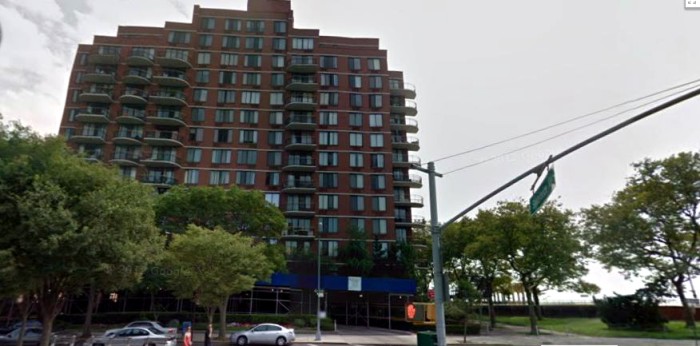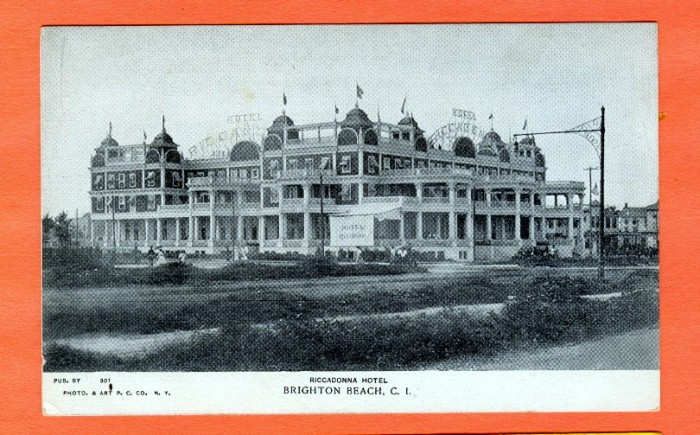Past and Present: The Riccadonna Hotel
A look at Brooklyn, then and now. Coney Island wasn’t always honkytonk and amusement parks. Before the first rides, before Steeplechase Park, Luna Park and Dreamland, before the infamous Bowery and its lewd entertainment, there was the beach. The cooling ocean breezes, the fresh air, and the beautiful beach were the first draws to Coney…


A look at Brooklyn, then and now.
Coney Island wasn’t always honkytonk and amusement parks. Before the first rides, before Steeplechase Park, Luna Park and Dreamland, before the infamous Bowery and its lewd entertainment, there was the beach. The cooling ocean breezes, the fresh air, and the beautiful beach were the first draws to Coney Island, Brighton and Manhattan Beaches. Entirely new lines of transportation were established to get day trippers and summer travelers to the beaches, enormous hotels were constructed, and it would seem that the entire world revolved around getting people to the shore, where they could sit on wide porches and be served cooling drinks, or stroll along the boardwalk. And we’re not talking the poor folks suffering in their tenements, either. All of this was geared towards the well-to-do. Coney Island was originally for the rich.
The hotels started out relatively small, but like many things Victorian, they soon grew to immense proportions. The Oriental Hotel, the Brighton Beach Hotel and others were enormous institutions, with hundreds of rooms, as well as lavish dining rooms, parlors and ballrooms. The hotels especially prided themselves on their dining rooms and restaurants, filling their kitchens with top chefs, some of them from Manhattan’s best restaurants, and expert wait staff ready to tend to their every need. The resort hotels advertised themselves to be on the par with the best resort hotels on Long Island, Newport, Saratoga Springs, and the Jersey Shore, all prime destinations for New York City and Brooklyn’s wealthy set who wanted to leave the stink and heat of the city in the summer.
The Riccadonna Hotel was a late arrival to this scene. In fact, by the time it opened in 1906, Coney Island was no longer the rich man’s resort. The amusement parks were being built, and more and more, the area was becoming a summer destination for everyone. But the Riccadonna did have a couple of things going for it that boded well for its success. First of all, there was the name.
Abele Riccadonna was an Italian immigrant who made good. He came here with thousands of other Italian immigrants in the latter part of the 19th century, and soon established himself as a caterer of note. That success turned into a large and ultimately very popular restaurant in Union Square, the heart of the theater and entertainment district in Manhattan, at the time. It opened in 1888, and was soon the place to be and been seen. Dining at Riccadonna’s was an experience, on the par with dining at any of today’s choicest restaurants of the day, and was mentioned in the same breath as Delmonico’s, and other swanky Manhattan restaurants. Abele died in 1902, but before he died, he had been able to open a second restaurant on W. 27th Street, as well as starting the negotiations for a new Coney Island hotel bearing the family name.
The hotel that became the Riccadonna was already there, at the intersection of Ocean Parkway and Sea Breeze Avenue, just across the street from the Brighton Beach Music Hall, and right near the Brighton Racetrack. The hotel was called the Shelbourne, and had been built in 1904. It was a three story wood framed building, a huge pile with expansive dining rooms and other public rooms, 150 guest rooms and 65 bathrooms. Every room also had a telephone. The Riccadonna opened with great fanfare in 1906, welcoming guests, and feeding them in the same way they were used to in Manhattan. The dining rooms could hold more than 2000 people at a time, and it was a hit, especially with the moneyed race track set.
In 1909, the hotel got enlarged and revamped, and now had 200 guest rooms, and all new dining rooms, parlors, smoking, writing and billiard rooms. That same year, fierce summer hurricane-like storms pounded Coney Island in August, with large waves lapping at the resorts and amusements. People came out from the city in order to watch nature’s fury, and those at the Riccadonna found the hotel surrounded by water, which didn’t go down for days. The hotel suffered some cellar damage, but was otherwise in good shape.
In January of 1911, the hotel was sold by its owners, a realty company called Somerville & Gottlieb, which also owned Manhattan restaurants. They sold the hotel to another similar company called Lust & Greenwald, which also owned some high end Manhattan restaurants. They were going to change the name to the Jefferson Hotel, and offer “high grade service at popular prices.” That same year, in April, there was a serious fire at the hotel, which destroyed the northwest section of the building. That was also the year much of Coney Island burned down, with disastrous fires destroying Dreamland, as well as other fires at different attractions on the island.
It gets a little confusing here, because I found two different accounts of the Riccadonna Hotel. In most accounts, the hotel changed hands as I described above, in 1911. But in another account, written in 1927, the hotel changed hands to a different new owner in 1910. That particular story goes on to say that the hotel was renamed the Shelbourne (again?) and lasted until 1927, when it was torn down for a new hotel that was supposed to be built on the site. In any case, the Riccadonna is only a memory now, one of the great resort hotels that once graced the shores of Coney Island. Today, a modern apartment building is on the site. The people who live there still have that same great view. GMAP








What's Your Take? Leave a Comment